High Burden of TB and Its Impact on Bangladesh Garment Workers
VerifiedAdded on 2020/09/17
|6
|1258
|54
Report
AI Summary
This report analyzes the significant impact of Tuberculosis (TB) on garment factory workers in Bangladesh, highlighting the country's demographics, the prevalence of TB, and the role of the garment industry. With a large workforce of 3.5 million in over 4,000 factories, Bangladesh faces a high TB incidence, with approximately 360,000 cases reported in 2015. The report discusses risk factors like the aging population and the challenges of poverty and low wages. It examines the government's efforts, including the "Mobilization Plan to Halve Tuberculosis Incidence in Ten Years," and the effectiveness of Latent TB Infection (LTBI) screening and treatment, particularly among at-risk garment workers. The conclusion emphasizes the ongoing transmission of TB within factories and the potential of LTBI programs to reduce infection rates and eventually eliminate TB, especially among low-income garment workers. The report references several studies and data sources to support its findings.
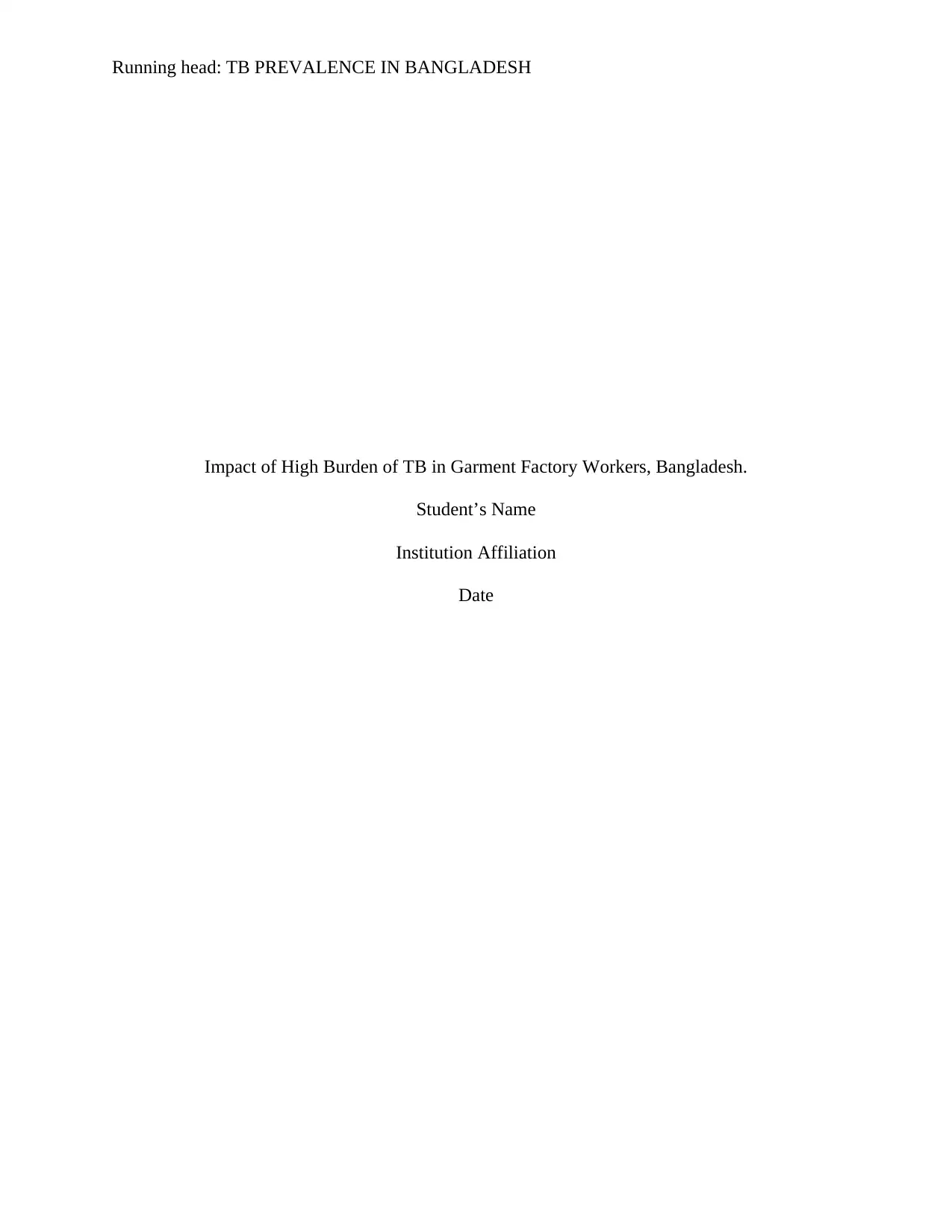
Running head: TB PREVALENCE IN BANGLADESH
Impact of High Burden of TB in Garment Factory Workers, Bangladesh.
Student’s Name
Institution Affiliation
Date
Impact of High Burden of TB in Garment Factory Workers, Bangladesh.
Student’s Name
Institution Affiliation
Date
Paraphrase This Document
Need a fresh take? Get an instant paraphrase of this document with our AI Paraphraser
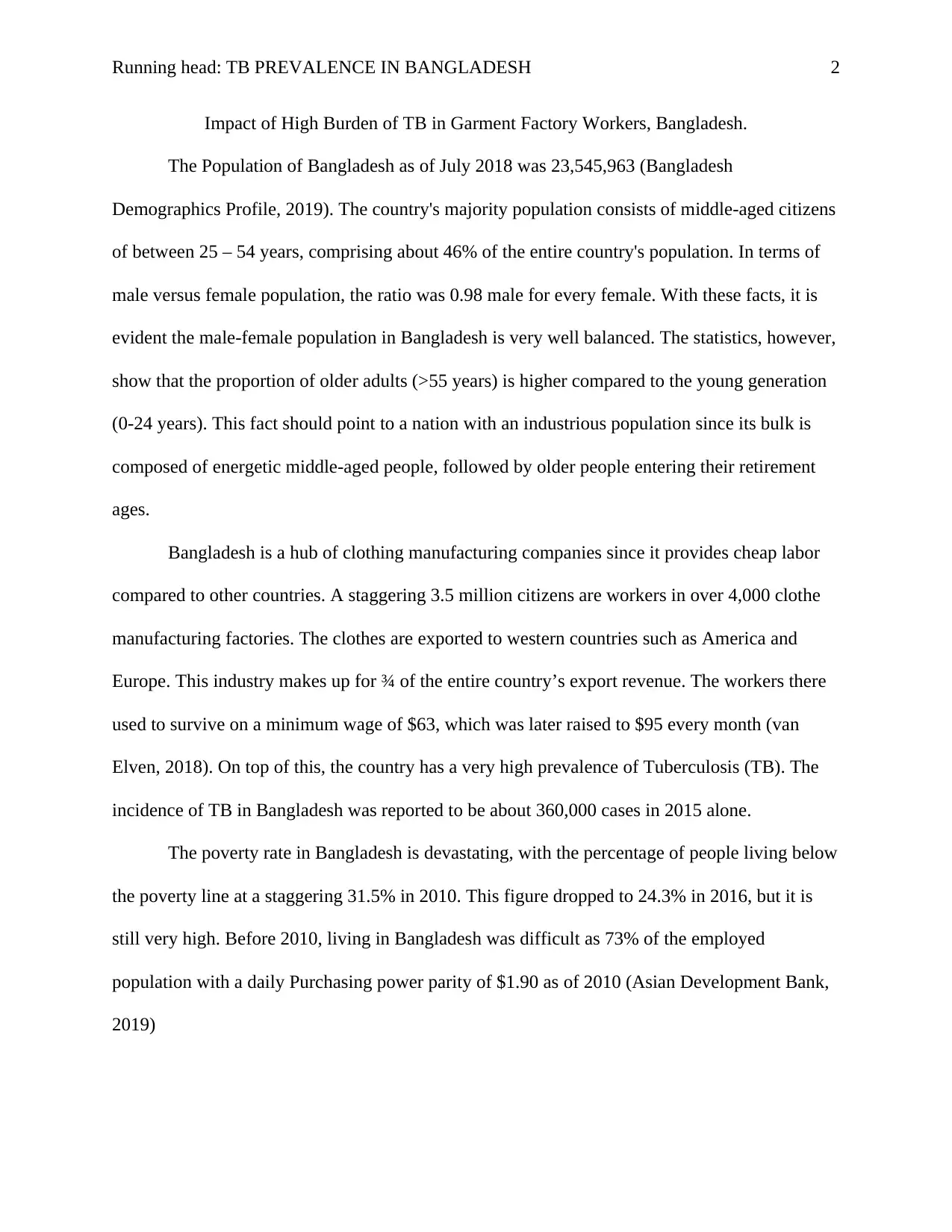
Running head: TB PREVALENCE IN BANGLADESH 2
Impact of High Burden of TB in Garment Factory Workers, Bangladesh.
The Population of Bangladesh as of July 2018 was 23,545,963 (Bangladesh
Demographics Profile, 2019). The country's majority population consists of middle-aged citizens
of between 25 – 54 years, comprising about 46% of the entire country's population. In terms of
male versus female population, the ratio was 0.98 male for every female. With these facts, it is
evident the male-female population in Bangladesh is very well balanced. The statistics, however,
show that the proportion of older adults (>55 years) is higher compared to the young generation
(0-24 years). This fact should point to a nation with an industrious population since its bulk is
composed of energetic middle-aged people, followed by older people entering their retirement
ages.
Bangladesh is a hub of clothing manufacturing companies since it provides cheap labor
compared to other countries. A staggering 3.5 million citizens are workers in over 4,000 clothe
manufacturing factories. The clothes are exported to western countries such as America and
Europe. This industry makes up for ¾ of the entire country’s export revenue. The workers there
used to survive on a minimum wage of $63, which was later raised to $95 every month (van
Elven, 2018). On top of this, the country has a very high prevalence of Tuberculosis (TB). The
incidence of TB in Bangladesh was reported to be about 360,000 cases in 2015 alone.
The poverty rate in Bangladesh is devastating, with the percentage of people living below
the poverty line at a staggering 31.5% in 2010. This figure dropped to 24.3% in 2016, but it is
still very high. Before 2010, living in Bangladesh was difficult as 73% of the employed
population with a daily Purchasing power parity of $1.90 as of 2010 (Asian Development Bank,
2019)
Impact of High Burden of TB in Garment Factory Workers, Bangladesh.
The Population of Bangladesh as of July 2018 was 23,545,963 (Bangladesh
Demographics Profile, 2019). The country's majority population consists of middle-aged citizens
of between 25 – 54 years, comprising about 46% of the entire country's population. In terms of
male versus female population, the ratio was 0.98 male for every female. With these facts, it is
evident the male-female population in Bangladesh is very well balanced. The statistics, however,
show that the proportion of older adults (>55 years) is higher compared to the young generation
(0-24 years). This fact should point to a nation with an industrious population since its bulk is
composed of energetic middle-aged people, followed by older people entering their retirement
ages.
Bangladesh is a hub of clothing manufacturing companies since it provides cheap labor
compared to other countries. A staggering 3.5 million citizens are workers in over 4,000 clothe
manufacturing factories. The clothes are exported to western countries such as America and
Europe. This industry makes up for ¾ of the entire country’s export revenue. The workers there
used to survive on a minimum wage of $63, which was later raised to $95 every month (van
Elven, 2018). On top of this, the country has a very high prevalence of Tuberculosis (TB). The
incidence of TB in Bangladesh was reported to be about 360,000 cases in 2015 alone.
The poverty rate in Bangladesh is devastating, with the percentage of people living below
the poverty line at a staggering 31.5% in 2010. This figure dropped to 24.3% in 2016, but it is
still very high. Before 2010, living in Bangladesh was difficult as 73% of the employed
population with a daily Purchasing power parity of $1.90 as of 2010 (Asian Development Bank,
2019)
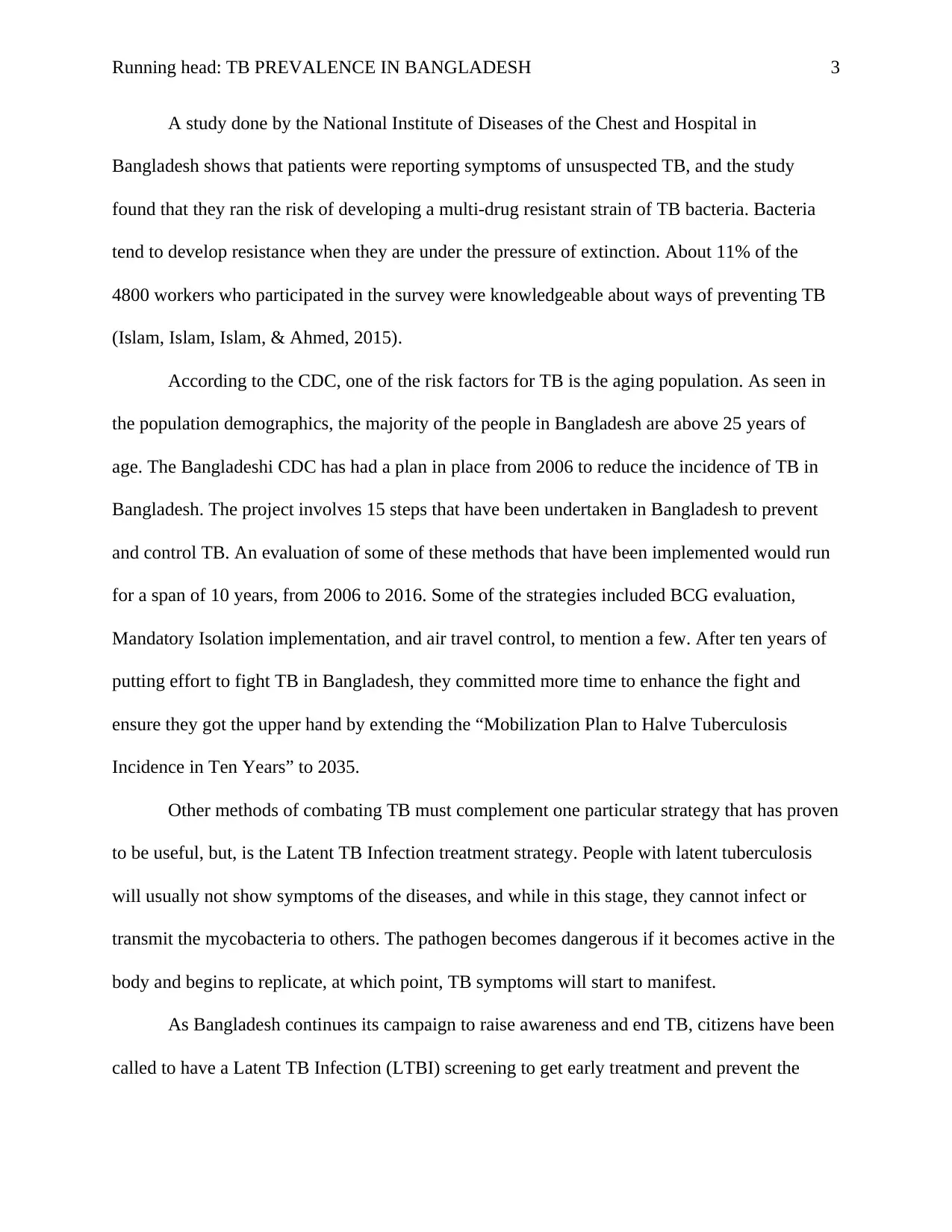
Running head: TB PREVALENCE IN BANGLADESH 3
A study done by the National Institute of Diseases of the Chest and Hospital in
Bangladesh shows that patients were reporting symptoms of unsuspected TB, and the study
found that they ran the risk of developing a multi-drug resistant strain of TB bacteria. Bacteria
tend to develop resistance when they are under the pressure of extinction. About 11% of the
4800 workers who participated in the survey were knowledgeable about ways of preventing TB
(Islam, Islam, Islam, & Ahmed, 2015).
According to the CDC, one of the risk factors for TB is the aging population. As seen in
the population demographics, the majority of the people in Bangladesh are above 25 years of
age. The Bangladeshi CDC has had a plan in place from 2006 to reduce the incidence of TB in
Bangladesh. The project involves 15 steps that have been undertaken in Bangladesh to prevent
and control TB. An evaluation of some of these methods that have been implemented would run
for a span of 10 years, from 2006 to 2016. Some of the strategies included BCG evaluation,
Mandatory Isolation implementation, and air travel control, to mention a few. After ten years of
putting effort to fight TB in Bangladesh, they committed more time to enhance the fight and
ensure they got the upper hand by extending the “Mobilization Plan to Halve Tuberculosis
Incidence in Ten Years” to 2035.
Other methods of combating TB must complement one particular strategy that has proven
to be useful, but, is the Latent TB Infection treatment strategy. People with latent tuberculosis
will usually not show symptoms of the diseases, and while in this stage, they cannot infect or
transmit the mycobacteria to others. The pathogen becomes dangerous if it becomes active in the
body and begins to replicate, at which point, TB symptoms will start to manifest.
As Bangladesh continues its campaign to raise awareness and end TB, citizens have been
called to have a Latent TB Infection (LTBI) screening to get early treatment and prevent the
A study done by the National Institute of Diseases of the Chest and Hospital in
Bangladesh shows that patients were reporting symptoms of unsuspected TB, and the study
found that they ran the risk of developing a multi-drug resistant strain of TB bacteria. Bacteria
tend to develop resistance when they are under the pressure of extinction. About 11% of the
4800 workers who participated in the survey were knowledgeable about ways of preventing TB
(Islam, Islam, Islam, & Ahmed, 2015).
According to the CDC, one of the risk factors for TB is the aging population. As seen in
the population demographics, the majority of the people in Bangladesh are above 25 years of
age. The Bangladeshi CDC has had a plan in place from 2006 to reduce the incidence of TB in
Bangladesh. The project involves 15 steps that have been undertaken in Bangladesh to prevent
and control TB. An evaluation of some of these methods that have been implemented would run
for a span of 10 years, from 2006 to 2016. Some of the strategies included BCG evaluation,
Mandatory Isolation implementation, and air travel control, to mention a few. After ten years of
putting effort to fight TB in Bangladesh, they committed more time to enhance the fight and
ensure they got the upper hand by extending the “Mobilization Plan to Halve Tuberculosis
Incidence in Ten Years” to 2035.
Other methods of combating TB must complement one particular strategy that has proven
to be useful, but, is the Latent TB Infection treatment strategy. People with latent tuberculosis
will usually not show symptoms of the diseases, and while in this stage, they cannot infect or
transmit the mycobacteria to others. The pathogen becomes dangerous if it becomes active in the
body and begins to replicate, at which point, TB symptoms will start to manifest.
As Bangladesh continues its campaign to raise awareness and end TB, citizens have been
called to have a Latent TB Infection (LTBI) screening to get early treatment and prevent the
⊘ This is a preview!⊘
Do you want full access?
Subscribe today to unlock all pages.

Trusted by 1+ million students worldwide
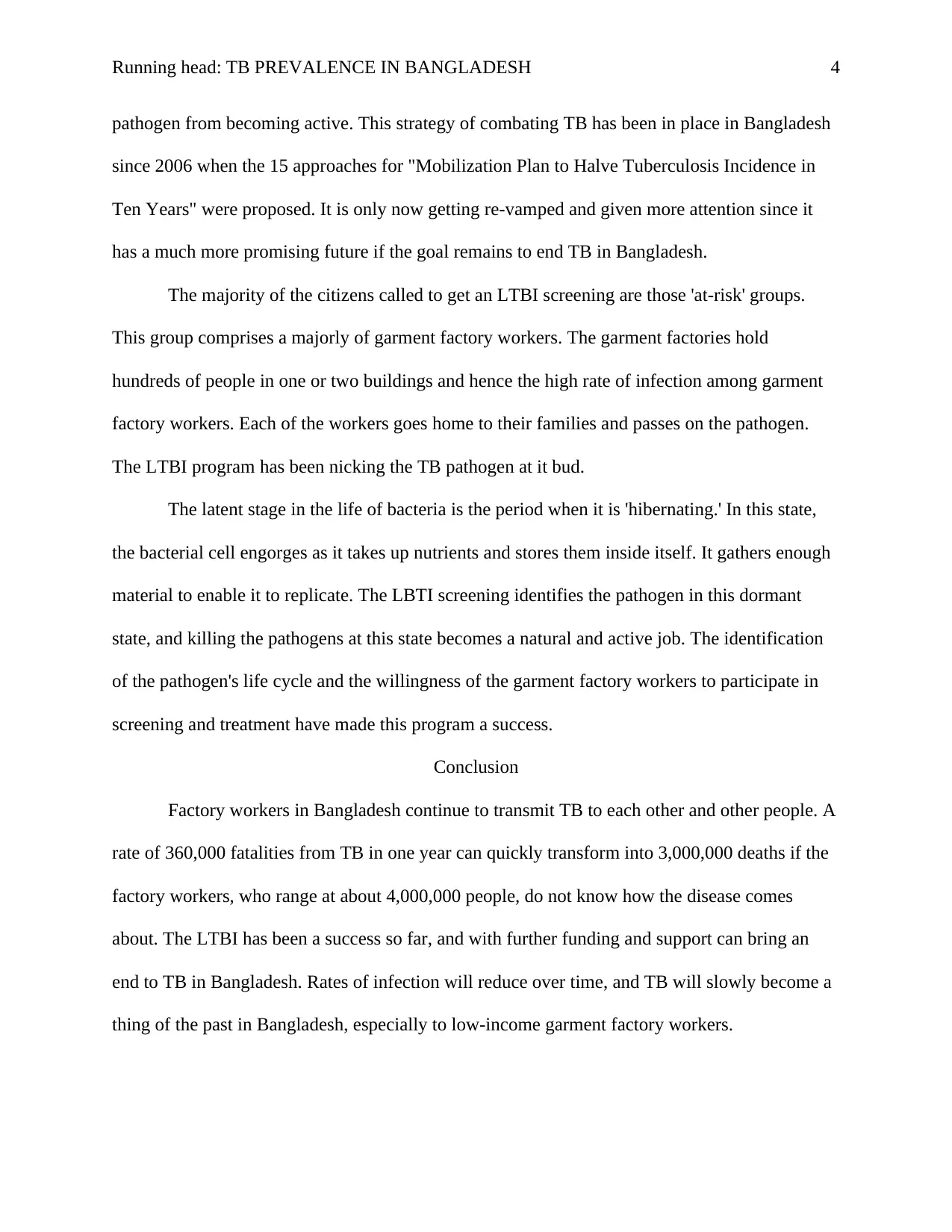
Running head: TB PREVALENCE IN BANGLADESH 4
pathogen from becoming active. This strategy of combating TB has been in place in Bangladesh
since 2006 when the 15 approaches for "Mobilization Plan to Halve Tuberculosis Incidence in
Ten Years" were proposed. It is only now getting re-vamped and given more attention since it
has a much more promising future if the goal remains to end TB in Bangladesh.
The majority of the citizens called to get an LTBI screening are those 'at-risk' groups.
This group comprises a majorly of garment factory workers. The garment factories hold
hundreds of people in one or two buildings and hence the high rate of infection among garment
factory workers. Each of the workers goes home to their families and passes on the pathogen.
The LTBI program has been nicking the TB pathogen at it bud.
The latent stage in the life of bacteria is the period when it is 'hibernating.' In this state,
the bacterial cell engorges as it takes up nutrients and stores them inside itself. It gathers enough
material to enable it to replicate. The LBTI screening identifies the pathogen in this dormant
state, and killing the pathogens at this state becomes a natural and active job. The identification
of the pathogen's life cycle and the willingness of the garment factory workers to participate in
screening and treatment have made this program a success.
Conclusion
Factory workers in Bangladesh continue to transmit TB to each other and other people. A
rate of 360,000 fatalities from TB in one year can quickly transform into 3,000,000 deaths if the
factory workers, who range at about 4,000,000 people, do not know how the disease comes
about. The LTBI has been a success so far, and with further funding and support can bring an
end to TB in Bangladesh. Rates of infection will reduce over time, and TB will slowly become a
thing of the past in Bangladesh, especially to low-income garment factory workers.
pathogen from becoming active. This strategy of combating TB has been in place in Bangladesh
since 2006 when the 15 approaches for "Mobilization Plan to Halve Tuberculosis Incidence in
Ten Years" were proposed. It is only now getting re-vamped and given more attention since it
has a much more promising future if the goal remains to end TB in Bangladesh.
The majority of the citizens called to get an LTBI screening are those 'at-risk' groups.
This group comprises a majorly of garment factory workers. The garment factories hold
hundreds of people in one or two buildings and hence the high rate of infection among garment
factory workers. Each of the workers goes home to their families and passes on the pathogen.
The LTBI program has been nicking the TB pathogen at it bud.
The latent stage in the life of bacteria is the period when it is 'hibernating.' In this state,
the bacterial cell engorges as it takes up nutrients and stores them inside itself. It gathers enough
material to enable it to replicate. The LBTI screening identifies the pathogen in this dormant
state, and killing the pathogens at this state becomes a natural and active job. The identification
of the pathogen's life cycle and the willingness of the garment factory workers to participate in
screening and treatment have made this program a success.
Conclusion
Factory workers in Bangladesh continue to transmit TB to each other and other people. A
rate of 360,000 fatalities from TB in one year can quickly transform into 3,000,000 deaths if the
factory workers, who range at about 4,000,000 people, do not know how the disease comes
about. The LTBI has been a success so far, and with further funding and support can bring an
end to TB in Bangladesh. Rates of infection will reduce over time, and TB will slowly become a
thing of the past in Bangladesh, especially to low-income garment factory workers.
Paraphrase This Document
Need a fresh take? Get an instant paraphrase of this document with our AI Paraphraser
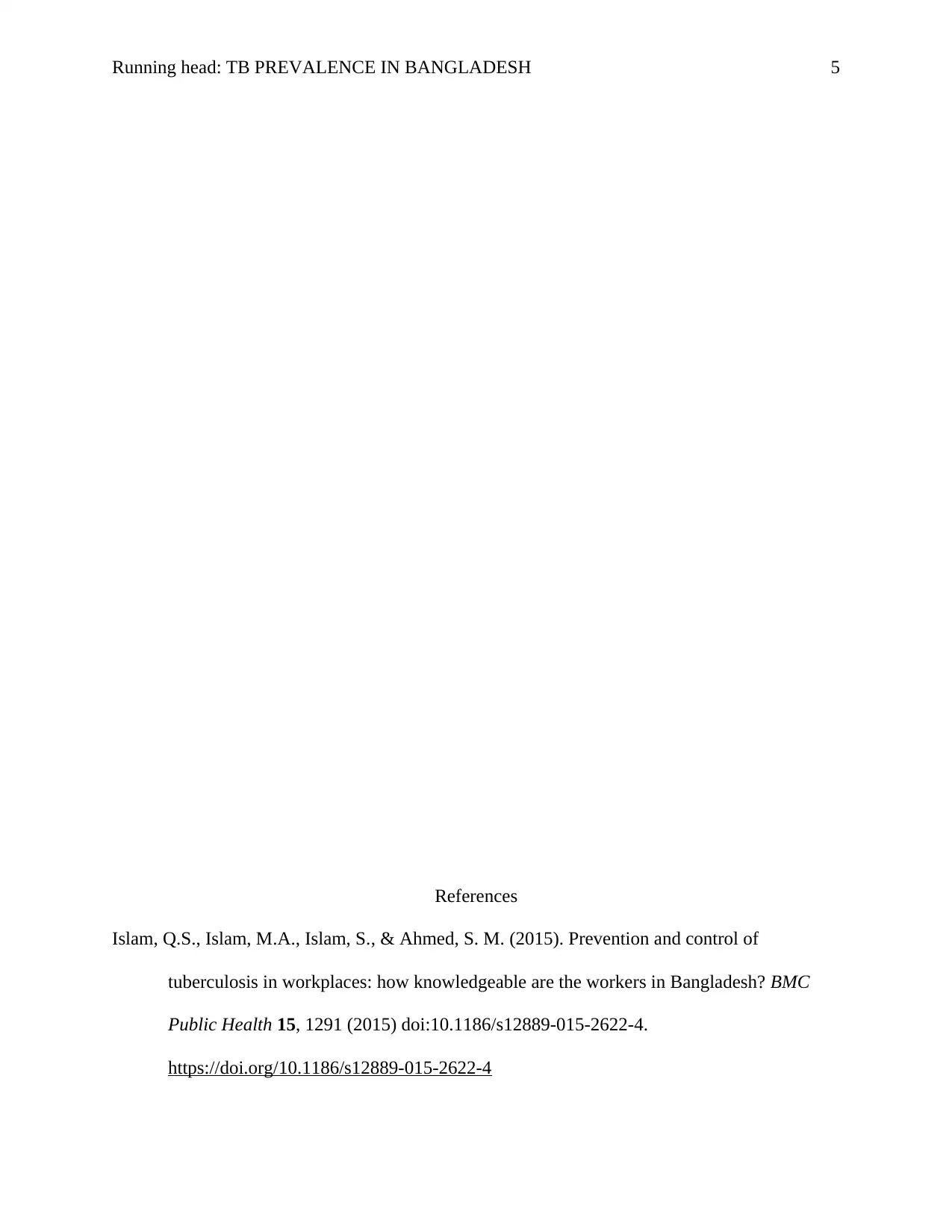
Running head: TB PREVALENCE IN BANGLADESH 5
References
Islam, Q.S., Islam, M.A., Islam, S., & Ahmed, S. M. (2015). Prevention and control of
tuberculosis in workplaces: how knowledgeable are the workers in Bangladesh? BMC
Public Health 15, 1291 (2015) doi:10.1186/s12889-015-2622-4.
https://doi.org/10.1186/s12889-015-2622-4
References
Islam, Q.S., Islam, M.A., Islam, S., & Ahmed, S. M. (2015). Prevention and control of
tuberculosis in workplaces: how knowledgeable are the workers in Bangladesh? BMC
Public Health 15, 1291 (2015) doi:10.1186/s12889-015-2622-4.
https://doi.org/10.1186/s12889-015-2622-4
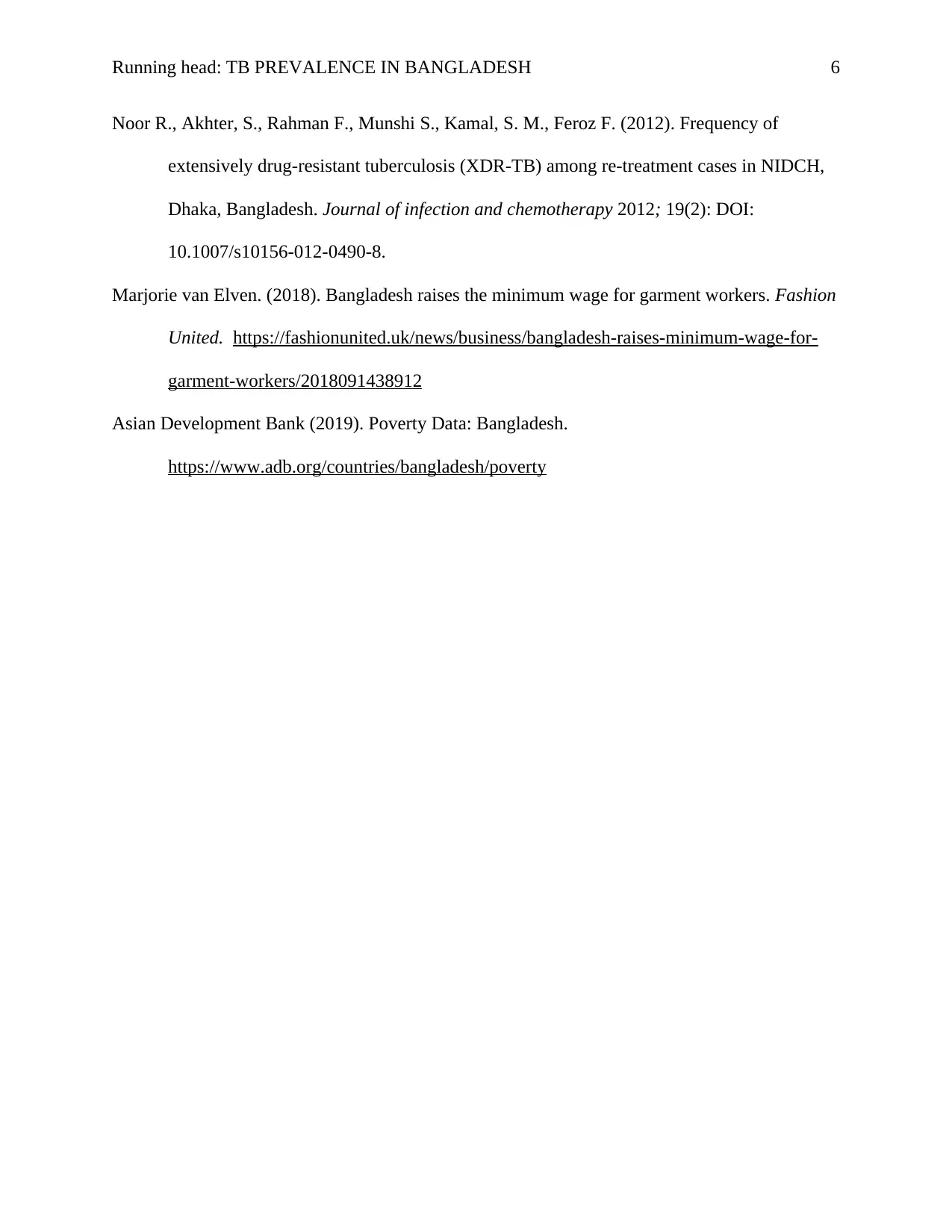
Running head: TB PREVALENCE IN BANGLADESH 6
Noor R., Akhter, S., Rahman F., Munshi S., Kamal, S. M., Feroz F. (2012). Frequency of
extensively drug-resistant tuberculosis (XDR-TB) among re-treatment cases in NIDCH,
Dhaka, Bangladesh. Journal of infection and chemotherapy 2012; 19(2): DOI:
10.1007/s10156-012-0490-8.
Marjorie van Elven. (2018). Bangladesh raises the minimum wage for garment workers. Fashion
United. https://fashionunited.uk/news/business/bangladesh-raises-minimum-wage-for-
garment-workers/2018091438912
Asian Development Bank (2019). Poverty Data: Bangladesh.
https://www.adb.org/countries/bangladesh/poverty
Noor R., Akhter, S., Rahman F., Munshi S., Kamal, S. M., Feroz F. (2012). Frequency of
extensively drug-resistant tuberculosis (XDR-TB) among re-treatment cases in NIDCH,
Dhaka, Bangladesh. Journal of infection and chemotherapy 2012; 19(2): DOI:
10.1007/s10156-012-0490-8.
Marjorie van Elven. (2018). Bangladesh raises the minimum wage for garment workers. Fashion
United. https://fashionunited.uk/news/business/bangladesh-raises-minimum-wage-for-
garment-workers/2018091438912
Asian Development Bank (2019). Poverty Data: Bangladesh.
https://www.adb.org/countries/bangladesh/poverty
⊘ This is a preview!⊘
Do you want full access?
Subscribe today to unlock all pages.

Trusted by 1+ million students worldwide
1 out of 6
Your All-in-One AI-Powered Toolkit for Academic Success.
+13062052269
info@desklib.com
Available 24*7 on WhatsApp / Email
![[object Object]](/_next/static/media/star-bottom.7253800d.svg)
Unlock your academic potential
Copyright © 2020–2025 A2Z Services. All Rights Reserved. Developed and managed by ZUCOL.
